|
Rhodesian
Specialist |
|
Ormskirk
Stamps |
|
|
COLLECTING
SOUTHERN RHODESIA |
|
|
|
An
Informative Section on the
Philately of Southern
Rhodesia |
|
|
|
This
section of the website was previously under Southern Rhodesia
and was perhaps overlooked by many and it has a more appropriate
place in The Rhodesian Philatelist
sector.
It is hoped that those of you
who have an interest in Southern Rhodesia will take advantage
of the information on offer |
|
|
1924
Admirals set to 2s 6d Cancelled on the first Day of Issue 1
APR 24
|
|
|
1923
- 1924 Introduction to the Interim Period |
|
|
|
I
published the original version of this article in July 1993
in the first edition of my magazine The
Rhodesian Philatelist
An edited account was published in ‘Gibbons Stamp Monthly’
in March & April 1998, I have recently completely revised
and rewritten this article which will be published in due course
What follows is very much an abbreviated
account
|
|
|
The
Interim Period - 1st October 1923 to 31st March 1924
The End of the British South Africa Company Era
|
|
|
Collections
of Southern and Northern Rhodesia invariably start with their
first definitives, issued on 1st April 1924 and 1925 respectively.
What many Individuals do not take into account is that Southern
Rhodesia was granted Self Government on 1st
October 1923 and from the 1st April, 1924 Northern Rhodesia
was administrated by the Imperial Government under the direction
of the Colonial Office.
These two dates mark the end of the British South Africa Company's
administration in the two territories.
Leading up to the above events the British South Africa Company
wished to dispose of the remaining stocks of stamps held by
the Company in London and as early as July 1923 they had approached
certain dealers in England with the view to disposing of their
holding. Stanley Gibbons acquired this stock and the first details
of the transaction was disclosed in the Stamp
Collector's Fortnightly dated 29th March, 1924.
This was followed by an explanatory statement by Stanley Gibbons
in their April edition of the Monthly
Journal.
They stated that no remainders of the 1913-22 King's portrait
were either offered or available for sale.
This is quite understandable as the Admiral issue was still
required for postage and revenue purposes in Northern and Southern
Rhodesia for an interim period from the end of the BSAC Administration
until the issue of new definitives in each Territory.
In Southern Rhodesia that period was from 1st October, 1923
to 31st March 1924 and in Northern Rhodesia from
1st April, 1924 to 31st March, 1925. |
|
|
Considerations
by the Post Office leading up to Self Government |
|
|
An extract from
a letter dated 31st July, 1923 from the Postmaster General Alfred
Ernest Holloway (P.M.G. 1921-28) to the Treasurer reads:
It is assumed that it will be desired to issue an entirely new
set of stamps and to place that issue on sale locally as soon
as possible after the 1st of October next. It is very doubtful
if it would be feasible to put the new issue into circulation
by that date owing to the short time available.
During the period which may elapse between the 1st of October
and the introduction of the new issue I would suggest that the
existing stamps be made use of in their present condition and
without surcharge or overprinting of any description.
If this be decided on it will be necessary for the British South
Africa Company to forward the whole of the remaining stocks
held by their London Office to this country and that no more
shall be printed except at the request of the local Administration,
the requirements of Northern Rhodesia being met from here.
When the new issue has been placed on sale and the question
of the stamps to be used in Northern Rhodesia after the 1st
April next has been decided the whole of the remaining stamps
of the present issue should be destroyed in the presence of
senior officials of the Auditor General's and the Postal Departments
who will certify accordingly. The existing dies should also
be sent out and similarly treated, or a certificate of destruction
be obtained from Messrs Waterlow and Sons.
The PMG’s letter goes on to provide details of the suggested
denominations for postage and revenue stamps plus the postal
stationery requirements and also suggested: As regards design
I would suggest that it be as simple as possible and that the
design at present in use would be quite suitable provided the
words "British South Africa" be replaced
by "Southern Rhodesia".
In the concluding sentence he wrote: ‘I may add that I
agree most unreservedly with the opinion expressed in the letter
from the Philatelic Society as to the extreme undesirability
of sanctioning any surcharge or overprint if the temporary use
of the existing issue is continued after the 30th September
next. |
|
|
The
Interim Definitives of Southern Rhodesia |
|
|
All stamps used
between 1st October 1923 and 31st March 1924 may be described
as Southern Rhodesia provisionals or forerunners and only examples
with readable dates can be placed in such a category. The only
stamps that I have encountered, used during the interim period,
have been from the Admiral issue.
Self Government took effect on Monday 1st October 1923
with Sir Charles Coghlan as the First Premier.
The interim period for B.S.A.C. Admirals was six months and
Southern Rhodesia's first definitive was placed on sale Tuesday
1st April 1924. The Admirals were withdrawn on 31st March, 1924
and remained valid for postage for a further month until 30th
April, 1924. A further five months of grace was allowed during
which time the stamps of the old issue could be exchanged for
those of the new issue. |
|
|
|
UMTALI
30 SEP 23
Last day
BSAC Administration |
WANKIES
1 OCT 1923
First day
Self Government |
GUTU
31 MAR 1924
Last day
On Sale |
GWANDA
1 APR 24
Day of
Withdrawal |
|
|
Postal
validity of the B.S.A.C. Admirals ended on Wednesday 30th April
1924 |
|
|
Late Usage is
known on numerous singles, pairs, blocks and larger multiples
all cancelled with a double ring MACHEKE 9 MAY 24, in my opinion
they were almost certainly executed by favour.
Illustrated below at left is a 1½d Admiral on piece cancelled
WILLOUGHBY’S HALT 13 MAY 1924 and this example appears
to have passed through the system unnoticed as the normal policy
was not to cancel invalid stamps |
|
|
In
Southern Rhodesia the Admirals were demonetized on 1st October,
1924 |
|
BSAC
Postal Stationery used during the Interim Period |
The B.S.A.C. Postal Stationery
also remained in use during the interim period. It has not been
established whether the same rules applied to the stationery regarding
the dates of withdrawal, exchange and demonetization and the postal
notices seen specifically refer to the stamps.
The vast majority of Stationery used during the interim period
is of the type with the Admiral imprint with the exception of
two items, both sent by
P. Falk, a 2½d Arms envelope H&G 3 used LALAPANZI 22
MAR 1924 & a 1d+1d Small Arms Post & Reply card H&G
12 used GWELO 10 DEC 1923.
Registered envelopes with Admiral Imprints do not exist.
The ½d Admiral Newspaper wrapper, virtually all
used examples seen are dated during the interim period and I have
only encountered one cancelled prior to 1st October 1923, the
date being DEC 1922. |
|
|
The
Southern Rhodesia Interim Period - Collecting possibilities |
|
LALAPANZI
17 SEP 1923 |
SALISBURY
29 SEP 23 |
UMTALI
- 30 SEP 23
Last day
BSAC Administration |
WANKIES
1 OCT 1923
First day Self Government |
VICTORIA
FALLS
3 OCT 1923 |
BULAWAYO
on SG 279c
7 OCT 23 |
PLUMTREE
26 OCT 23 |
|
|
September
1923 - Last month of B.S.A.C.
Administration - The
30th was a Sunday, thus it is a difficult date to find, thus
a few late dates are desirable
1st October 1923 First Day of Self
Government for Southern Rhodesia
A major challenge is finding 1st October; it is a very rare
item, or try & find an early day in the month |
|
|
|
|
A colourful
trio fiscally used on 19/10/23
Oval handstamp
RAILWAY PASSENGERS ASSURANCE
JOHANNESBURG |
|
|
|
1st October
1923 to 31st March 1924 There
are 183 days which includes 26 Sundays and Christmas Day
Desirable dates would be Monday 31st December 1923, Tuesday
1st January 1924 and Friday 29th February 1924 (leap year)
I suggest Stamps, both postal & fiscally used, Covers, Stationery
and Documents
Try finding items for every month with items dated either at
the beginning, middle or end of each month |
|
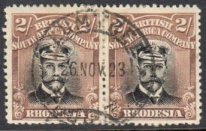
PLUMTREE
26 NOV 23 |
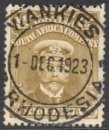
WANKIES
1 DEC 1923 |
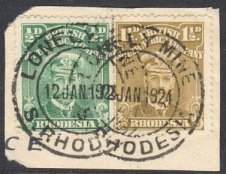
LONELY MINE
12 JAN 1924 |
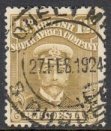 LONELY MINE
LONELY MINE
27 FEB 1924 |
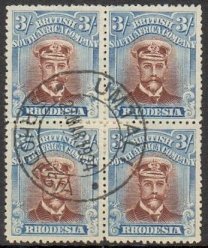 UMTALI
UMTALI
27 MAR 1924 |
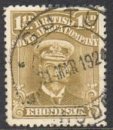 GUTU
GUTU
31 MAR 1924
Day of Withdrawal |
|
1st
April 1924 Date of issue of Southern Rhodesia's First Definitive
A First day cancellation
on an issued stamp is Very Rare and Covers are Extremely Rare
|
|
|
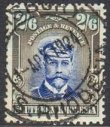
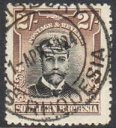
SALISBURY 1 APR 1924
First Day of issue |
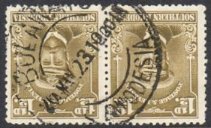
BULAWAYO - 23 MAY 23
A 1923 Date Error |
|
| |
April 1924 Last month of postal validity
for B.S.A.C. Admirals
|
|
| Post
Offices and Agencies in Southern Rhodesia |
|
|
September
1923 last month of B.S.A.C. Administration
Postal Notice 17/1923 TARN ESTATE closed 11th
September 1923.
New offices opened 11th September 1923 JENKINSTOWN, MAPUNGA
and WATSOMBA
There were 115 Post Offices and Agencies Open at Commencement
of Self Government 1st October 1923
The above are all listed in my article
Offices opened during interim period 1st October 1923
and 31st March 1924
CHRISTMAS PASS Open 11th February 1924 (PN5/1924) closed 1.3.34.
ZAKA Opened by 31st December, 1923. Opening confirmed by P.N.5/1924.
|
|
| 1924
- 31 Admiral Issue SG 1 - 14 |
|
|
|
|
|
|
|
| |
The Mono-coloured Low Values |
|
|
|
Introduction
A New Self Governing Southern Rhodesia issued their First Definitives
on 1 April 1924 and they remained in use for seven years. The
Stanley Gibbons Commonwealth Catalogue lists it as SG 1 to 14,
suggesting it is a dull and straight forward set of stamps.
The truth is far from that, with sixty six plus printings it
offers the specialist the challenge to seek all the various
shades. Some items are great rarities, for instance the 1927
1d Rosine, difficult used and virtually impossible mint; I have
only had one example of it.
The 1928 5/-,
only four sheets, 240 stamps printed specifically for the Stamp
Trade and distributed in ordinary sets to collectors. Many of
them are still part of ordinary collections with the owners
oblivious to the fact that they possess a rare stamp. Only recently
a friend informed me that he had bought a set of fourteen stamps
from a dealer in Canada as he suspected that the top value was
indeed the rare 1928 printing. After seeking verification, it
proved to be so.
In 1929 a 1d coil stamp
was issued and very few distributed via the vending machines
as they would not work properly. It is very common mint and
very scarce used and to locate a copy on cover a challenge of
a lifetime.
Part Imperforates and imperforate
between varieties abound, the former being beyond
the scope of the SG catalogue and the listing of the imperforate
between varieties is incomplete.
During the period that the Admirals were for sale several small
Postal Agencies opened and/or closed. The foregoing means that
there are some Extremely Rare Postmarks worth
looking for on this particular issue.
|
|
|
|
In
our Magazine
The
Rhodesian Philatelist
I have published several
articles on the 1924 - 31 Admirals
In issue No 22 - September 2002 I published
an extensive article on the printings & shades of the Admirals
A brief summary of the foregoing follows |
|
|
|
From the evidence
in the Waterlow archives we know that there were several printings
for each value and that in turn provides numerous shades worthy
of collecting and study
The Archives indicate a total of 66 printings for the set of
14 values being
½d (7) 1d (7) 1½d (3) 2d (6) 3d (6) 4d (4) 6d
(5) 8d (3) 10d (3) 1/- (7) 1/6 (3) 2/- (5) 2/6 (5) & 5/-
(2)
It is believed that the archival record is incomplete &
that there were more printings than suggested
My research has proven that there were at least three to four
5/- printings rather than only the two found in the archives
|
|
|
|
Bridger
& Kay created a superb archival record for
the Admirals by using the file sheets of 66 printings
Single perforated proofs were hinged onto an album page in sequence
of value and the print order of each proof has a number in pencil
on the reverse so that they cannot be mixed up should they be
taken off their page.
These archival collections consist of 65 punch hole proofs mounted
on two album Pages and each unit is accompanied by three tabulated
pages that provide the details of Printing dates, quantities
ordered and plate numbers used.
The 66th proof is the 1928 5/-
printing which was mounted separately onto a presentation card
As early as 1932 a guide to the various shades was available
in a Harris Publications booklet compiled by a Committee of
the Philatelic Society of Rhodesia entitled The
Postage Stamps of Southern Rhodesia - An Official Checklist
In this booklet there is a listing from two to five different
shades for each value and the foregoing was later incorporated
into the 1965 Mashonaland Guide
Considering the number of printings for this issue, it is disappointing
that this very interesting definitive has not been listed by
its shades in the Stanley Gibbons catalogue |
|
|
|
|
The only catalogue that did list
different shades for the values was the
1980 Five Reign Commonwealth catalogue
Published by Bridger & Kay
It is the only publication to list the rare 1928 5/- shade as
G14b - Then priced at £1750 mint & quite correctly
did not price it used and in my opinion it does not exist in
a used state.
The February 1928 5/- was for a total of four sheets only prepared
specifically for the stamp trade & it is thought that Ewen's
New Issue service distributed this printing. |
|
|
|
| 1924-31 Admirals - A
Summary of Shades
The dates noted are either
the month of issue (April 1924) or approximate printing
dates
My information has been gleaned from issued
stamps that match up with a particular proof
In the Bridger & Kay collection
Therefore please do not regard these dates as being
beyond dispute, they are merely my opinion
|
| SG |
Value |
|
Date |
SG |
Value |
|
Date |
| 1 |
½d |
Blue green |
|
7 |
6d |
Black & deep mauve |
03-29 |
| |
. |
Deep blue green |
|
|
|
Black & lilac |
|
| |
. |
Yellow green |
|
8 |
8d |
Violet & blue green |
04-24 |
| |
. |
Deep yellow green |
|
|
|
Violet & sage green |
10-24 |
| 2 |
1d |
Red |
|
|
|
Purple & pale green |
02-28 |
| |
. |
Scarlet (shades) |
|
9 |
10d |
Blue & rose red |
04-24 |
| |
. |
Rosine 1927 |
|
|
|
Blue & brown rose |
10-24 |
| |
. |
Vermilion 1928 |
|
|
|
Ultramarine & rose |
02-28 |
| 2c |
1d |
Coil red 1929 |
|
|
|
Deep ultramarine & rose |
|
| |
. |
Scarlet |
|
10 |
1/- |
Black & blue |
|
| 3 |
1½d |
Bistre |
|
|
|
Black & light blue |
|
| |
. |
Bistre brown |
09-24 |
|
|
Black & deep blue |
|
| |
. |
Yellow bistre |
|
|
|
Black & bluish green |
|
| |
. |
Pale bistre |
|
|
|
Black & milky blue |
|
| 4 |
2d |
Black & purple grey |
|
|
|
Black & turquoise blue |
|
| |
. |
Black & brown purple |
|
|
|
Grey Black & light blue |
|
| |
. |
Black & slate purple |
|
11 |
1/6 |
Black & yellow |
04-24 |
| 5 |
3d |
Deep blue |
|
|
|
Black & yellow chrome |
05-26 |
| |
. |
Pale blue |
09-24 |
|
|
Black & orange chrome |
04-27 |
| |
. |
Prussian blue |
05-26 |
12 |
2/- |
Black & yellow brown |
|
| |
. |
Ultramarine |
03-27 |
|
|
Black & purple brown |
|
| |
. |
Deep blue |
02-28 |
|
|
Black & brown |
|
| |
. |
Deep ultramarine |
03-29 |
13 |
2/6 |
Ultramarine & sepia |
|
| |
. |
Blue |
|
|
|
Dull blue & drab |
|
| |
. |
Milky blue |
|
|
|
Ultramarine & drab |
|
| 6 |
4d |
Black & orange red |
|
|
|
Ultramarine & grey brown |
|
| |
. |
Black & deep orange red
|
12-25 |
14 |
5/- |
Blue & turquoise green |
|
| 7 |
6d |
Black & mauve |
04-24 |
|
|
Ultramarine & blue green |
|
| |
. |
Black & pale mauve |
|
|
|
Light blue & dull blue green |
|
| |
. |
Black & purple |
08-24 |
|
1928 |
Deep blue & deep green |
02-28 |
| |
. |
Black & rosy mauve |
03-27 |
|
|
OR |
|
| |
. |
Black & red violet |
02-28 |
|
|
Deep blue & deep blue green |
|
| |
|
|
| 5/-
Admiral The so called 'Error of Colour' |
|
|
|
The 5/-
Former Error of Colour The 5/-
‘Error of colour’ was first listed in the 1927 Stanley
Gibbons catalogue as SG 14a blue and light blue. Remained unpriced
until 1934 when it was deleted. Still unpriced, it was reinstated
in 1937 and
was finally quoted at £18 in the 1940 edition.
W.G. Nodder in the 26 August 150
‘Stamp Mirror’ had this to say about this
variation:
Chemically manufactured error - The 5/-
value is also catalogued blue and light blue and is described
as “an error of colour” of which only two sheets.
i.e. 120 stamps were printed, but this error has been chemically
“manufactured” and it, behoves all collectors to
seek expert advice before purchasing what purports to be a genuine
specimen. Many specialists contend that this stamp should never
be chronicled as an “error” but merely as a separate
shade variety.
It last appeared in the 1978 catalogue,
by which time it had reached £1000 and the reason it was
deleted is as follows: In the April 1977 edition of The
Philatelist Robson Lowe wrote -
Nearly fifty years later the opportunity arose for me to
examine the file proof sheets kept by the printer and in the
top row of the imperforate registration sheet was a single copy
which had been cut out and replaced after treatment, showing
that the printers had been approached at the time and proved
that the light blue stamp was a fake. |
|
|
|
If
indeed the so called Error of colour was geniune, one would
not anticipate it one different Printings
|
|
| First
Version Ultamarine |
2nd
Version Blue |
3rd
Version Thick Paper |
Two
Fakes used on Piece |
|
|
Although the former Error
of Colour proved to be a changling, it is still
highly sought after and sells remarkably well in Auction and
in the Ivy, Shreve & Mader SAMOS
London sale 20 June 1991 - An example in
lot 1245 sold for £500 - the buyer was the well known
dealer and now the late Billy Lea.
|
|
|
1931
- 37 Definitives Field Marshall and Small Falls Issue |
|
½d
to 5/-
Field Marshall design printed by
Bradbury, Wilkinson |
2d
& 3d
Small Falls
printed by
Waterlow & Sons
|
|
|
On
30 April 1932 the 2d and 3d Small Falls stamps were withdrawn
from sale but they remained valid for postage until 31 October
1932. (Postal notice No 13 of 1932)
|
|
|
Postal notice No 13
of 1931
SOUTHERN RHODESIA – Postage Stamps: New Issue.
It is hereby notified for public information
that a new issue of postage and revenue stamps and stationery
will be on sale at all post offices on 1st April next.
Stamps of the present issue will be valid for postal and revenue
purposes until 30th September, 1931, after which date such
stamps and stationery will become obsolete and will cease
to be valid. Mail matter posted after the 30th September next
which bears stamps of the obsolete issue will be surcharged.
The new issue comprises stamps and stationery
of the following denominations and varieties:-
Stamps: ½d,
1d, 2d, 3d, 4d, 6d, 8d, 10d, 1s, 1s 6d, 2s, 2s 6d and 5s.
Post cards with
½d and 1½d stamp. Registered envelopes, large
and small, with 4d stamp.
Embossed envelopes,
large and small with ½d stamp. Embossed envelopes,
small, with 1d stamp.
Newspaper wrappers
with ½d stamp. Letter cards with 1d stamp.
Books of stamps
containing ½d and 1d stamps, value 2s 6d each, will
also be available.
J. COLLYER,
Postmaster-General.
|
|
| The
Field Marshal Printings including the Booklets |
|
|
| Order No & date
|
Details |
Values |
Sheet No’s |
| 18109
10 March 1930 |
Original
printings - Perforation 12
&
2/6 Booklet ½d & 1d panes of 6 |
Issued
1 April 1931 ½d, 1d, 4d,
6d,
8d, 10d, 1/-, 1/6, 2/-, 2/6 and 5/- |
None |
| 22054
26
January 1932 |
New value - Perforation
11½
Sheets of 240 (4
panes x 60) |
1½d
50,000 sheets (12
million stamps) |
To
500³
Seen
027 |
| 22108
9
February 1932 |
Reprint - Perforation
12 |
8d,
10d, 1/6 and 2/6 |
To
500³
Seen
008 & 068 |
| 22371
21
March 1932 |
Reprint - Perforation
11½ |
½d
and 1d |
To
500³ |
| 22372
21
March 1932¹ |
Reprint - Perforation
12 |
4d, 6d, 1/-, 2/-
& 5/- |
To
500³
Seen
065 |
| 22375
31
March 1932 |
3/- booklet - Perforation
12
Issued 3 March 1933 |
½d, 1d and 1½d (SG
16c) |
None |
| 24469
10
April 1933 |
Reprint - Perforation
11½ |
½d,
1d, 6d, 10d, 2/- and 2/6 |
From
000 |
| 26194²
2
February 1934 |
Reprint - Perforation
11½ |
6d |
1
to 500 |
| 26197
2
February 1934 |
Reprint - Perforation
11½ |
½d and 1d |
1
to 500 |
| 26198
2
February 1934 |
Reprint - Perforation
11½ |
4d,
8d, 10d, 1/-, 1/6, 2/- and 2/6 |
1
to 500 |
| 27187
11
July 1934 |
New value - Perforation
12 |
9d - In sheets of
sixty 10 x 6 |
1
to 500 |
| 28683
8
March 1935 |
Reprint - Perforation
14 |
½d
and 1d |
1
to 500 |
| 28684
8
March 1935 |
Reprint - Revert
to perforation 12 |
4d, 6d, 8d, 9d,
1/-, 1/6, 2/- & 5/- |
1
to 500 |
| 32134
13
August 1936 |
Reprint - Perforation
14 |
6d |
From
000 |
| 34307
22
June 1937 |
Reprint - Perforation
14 |
½d |
1
to 500 |
| 34447
12
July 1937 |
Reprint - Perforation
14 |
1d |
1
to 500 |
| 34448
12 July 1937 |
Reprint
- Perforation 14 |
4d,
6d and 1/- |
1 to 500 |
|
|
|
|
When
comparing different archival collections some pencil notations
conflict with each other: ¹ dates for 4d quoted as 26th
or 28th March & 2/- 26th March ² Order No stated as
26198 ³ Sheet No’s may reflect 001 - 099 to 500
|
|
|